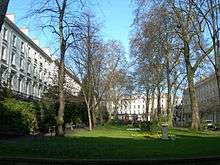Porchester Square
 Porchester Square Gardens | |
| Namesake | One of the Hampshire estates of the Thistlewaites |
|---|---|
| Type | Garden square |
| Area | Bayswater / Westbourne |
| Location | London, W2 |
| Construction | |
| Construction start | 1850 |
| Completion | 1855-58 |
Porchester Square is an archetypal-format London garden square in Bayswater, the district along the north of Hyde Park at a point where it blends into Westbourne. It is lined with tall white Victorian classical architecture residential buildings and is half of one major block south of the closing section of the Great Western Main Line that leads into London Paddington station.
History
The manor of Porchester, Hampshire belonged to the Thistlewaites whose head of family, with between two and three others, was the chief co-lessee and co-trustee of the Bishop of London's majority landholding of Paddington since before 1750. That arrangement continued, with much of the land since sold off, when building began on this rectangular plot in 1850. A variety of builders became involved, resulting in slightly different exterior details in the surrounding houses (in the modern age all converted into apartments). Classical features are porticoed steps to the front doors, sash windows, first floor balconies with wrought iron railings, multiple cornices and roofline balustrades.[1]
A rare feature nationally is that the front of houses on the northern side of the square do not face the square, instead they back onto it without an intervening road. A curious consequence is that the road onto which they do face has two names - Porchester Square on its southern side, but Gloucester Terrace on its northern.[1]
The houses on the south side, keeping their façades and much of their internal structure, have been incorporated into an award-winning wider private development of flats and commercial premises since the mid-1970s, The Colonnades. This development was one of the first major projects of architects whose status later grew, Sir Terry Farrell and Sir Nicholas Grimshaw.[2]
The central gardens of the square which are open to the public. It has large, well-rooted, tall London Plane trees (Platanus x hispanica), flowering cherry trees, extensive lawns, colourful flower beds and a children's playground.
Begun in 1850 and completed between 1855 and 1858, Porchester Square was one of the last areas of Bayswater and Westbourne to be built. Eight different builders were involved with different parts of the square as can be seen from a variety of exterior details on the houses. The architect most closely concerned with Porchester Square was George Wyatt, but the final word on both the general layout and the architectural detail would have been with George Gutch who in 1822 became the surveyor of Bishop of London's Paddington estate and so supervised the overall development of the whole of Bayswater. The name Porchester comes from one of the Hampshire estates of the Thistlewaites who with only two or three other families had been chief lessees of the Bishop of London's land in Paddington since before 1750. At the outset of building the area was considered in the parish and soon the Metropolitan Borough of Paddington, in 1965 the authority became the City of Westminster which took the borough as its northern part, dissolving it.[1]
References
- 1 2 3 "Paddington: Westbourne Green - British History Online".
- ↑ Terry Farrell & Company (Master Architect Series I), 2001, Farrell, T. Images Publishing Group Pty Ltd at Chapter 26: The Colonnades